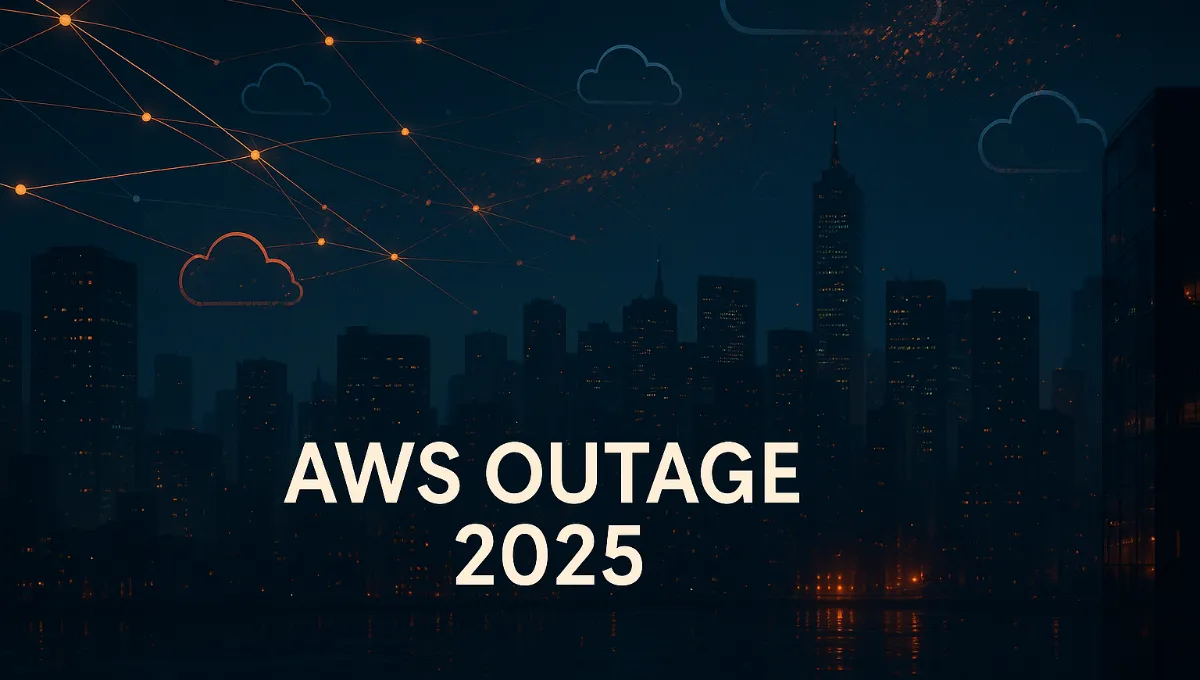When Amazon Web Services suddenly goes down, the entire internet feels it. On October 20, 2025, users around the world woke up to find their favorite apps failing to load, streaming services freezing, and websites timing out. Within minutes, the phrase “AWS outage” began trending on Google, X, and Reddit, as millions tried to figure out what had just happened to the backbone of the modern web.
What started as a regional disruption in AWS’s US-East-1 data center in Virginia quickly spiraled into a global cloud crisis. Reports poured in from across North America, Europe, and Asia: Fortnite was down, Snapchat stopped sending messages, and Alexa devices wouldn’t respond. Major companies relying on AWS infrastructure — from Venmo to Coinbase, Robinhood, and even government websites — found themselves unexpectedly offline.
For hours, confusion dominated both corporate IT departments and social media. Thousands of engineers scrambled to identify workarounds while frustrated users flooded Downdetector with complaints. The AWS status page confirmed “API errors and connectivity issues across multiple services,” and analysts began to speculate whether this could become one of the biggest outages in cloud history.
AWS, Amazon’s trillion-dollar cloud arm, powers much of the digital economy. Everything from Netflix recommendations to Spotify playlists, online shopping carts, and even emergency communication systems depend on it. So when AWS sneezes, the internet catches a cold. It’s not just a clever line — it’s a stark reality of how deeply interwoven the cloud has become in our daily lives.
As the hours passed, reports pointed toward a failure in AWS’s internal health monitoring system, specifically related to a load-balancer that handles traffic distribution across the DynamoDB service. This single malfunction cascaded through dependent services, triggering widespread throttling of new EC2 instances and API calls. The irony wasn’t lost on experts: a platform designed for resilience had been tripped up by its own redundancy protocols.
By late afternoon, partial recovery began. Yet the damage was done — not just technically, but reputationally. The AWS outage of October 2025 demonstrated how fragile even the most advanced infrastructure can be when centralization meets scale. The digital world learned, once again, that “the cloud” is just someone else’s computer, and even the world’s most powerful data centers can fail.
Businesses large and small faced ripple effects. Retailers couldn’t process payments, logistics networks stalled, and video-on-demand platforms saw viewer counts plunge. Some startups that depended exclusively on AWS reported losing up to 30% of daily revenue in a single afternoon. Meanwhile, enterprise clients demanded answers — and Amazon promised a full post-mortem report to explain what went wrong.
Experts noted that this outage resembled previous AWS disruptions in both scope and impact. The 2021 and 2023 incidents also originated from the same East-Coast region, highlighting how geographical concentration of resources remains a key vulnerability. Despite AWS’s claims of redundancy, the dependency chain between services — such as S3, EC2, Lambda, and Route 53 — creates situations where one regional fault can spread system-wide within minutes.
Social media, as usual, turned the chaos into spectacle. Memes circulated about “the day the internet stopped working,” while IT professionals traded horror stories about their dashboards lighting up like Christmas trees. #AWSdown trended for over twelve hours. Yet beyond the humor, there was genuine concern: How could a single company hold so much control over the world’s online experience?
The broader discussion that emerged from this outage wasn’t just technical — it was philosophical. Have we built the internet on too few shoulders? When AWS, Microsoft Azure, or Google Cloud experience problems, entire economies are affected. From streaming platforms to fintech systems and even government infrastructure, the dependence on centralized cloud providers has grown dangerously high.
Cybersecurity experts emphasized that the lesson isn’t to abandon the cloud, but to embrace diversification. Multi-cloud and hybrid-cloud strategies can reduce risk, allowing businesses to maintain continuity when one provider falters. Still, such architectures cost more and require complex integration, which is why many companies continue to put all their digital eggs in Amazon’s basket.
For consumers, the experience was a wake-up call. One moment they were ordering food through DoorDash or chatting on Snapchat; the next, everything froze. The illusion of digital permanence cracked. When AWS faltered, so did daily life — a subtle reminder of how invisible yet essential cloud infrastructure has become.
By the end of the day, Amazon announced that all major systems were “fully operational.” But the headlines lingered. The Guardian, Reuters, and the Times of India all led with variations of the same message: “Amazon’s cloud outage knocks out the internet.” The phrase alone sounds hyperbolic, yet it captured the truth — the modern web truly runs through AWS’s veins.
Economists estimate that even a few hours of downtime could cost billions in lost productivity and transactions globally. For Amazon, whose cloud division generates over 90 billion USD in annual revenue, this was more than a technical hiccup — it was a PR crisis. AWS’s reliability rating, often touted as “five nines” (99.999%), suddenly looked more fragile. Clients questioned whether they needed a backup plan that didn’t begin and end with Amazon.
Industry leaders reacted quickly. Microsoft Azure representatives pointed out their own redundancy systems in a subtle marketing jab, while Google Cloud announced a whitepaper on “resilient multi-provider infrastructure.” Smaller cloud companies seized the moment to advertise decentralized hosting solutions, hoping to capture some of the disillusioned enterprise clients.
Yet despite the backlash, AWS remains irreplaceable for now. Its global footprint, range of developer tools, and integration ecosystem are unmatched. The outage, paradoxically, reinforced its dominance — proving that when AWS goes down, the world notices. There’s no better advertisement for your importance than global panic at your absence.
Still, the human side of the story deserves attention. Engineers at AWS and partner companies reportedly worked around the clock, pulling 18-hour shifts to stabilize systems and restore uptime. These are the unseen heroes who keep the world’s cloud humming — and who often bear the brunt of online anger when things go wrong.
What remains now is reflection. The 2025 AWS outage wasn’t just a blip in the status logs; it was a glimpse into the precarious balance of our hyper-connected era. It reminded users, investors, and policymakers alike that resilience is not infinite, and digital dependency has real-world consequences.
In the weeks ahead, AWS will publish a detailed incident report, likely citing internal misconfigurations or unexpected hardware behaviors. The usual corporate reassurances will follow: new safeguards, enhanced monitoring, lessons learned. But beneath the technical jargon lies an uncomfortable truth — the internet, as vast as it seems, still leans on a few massive pillars. And when one cracks, the tremors are felt everywhere.
AWS outage today, AWS status October 2025, Amazon Web Services down, cloud disruption, tech infrastructure failure — these aren’t just search terms; they’re snapshots of a connected civilization realizing how fragile its foundations are. The more we build on the cloud, the more we depend on its unseen stability.
Perhaps the ultimate takeaway is this: technology’s greatest strength — interconnection — is also its greatest weakness. The Great AWS Outage of 2025 will fade from memory in a few weeks, but its echo will persist in boardrooms, code reviews, and digital strategy meetings worldwide. Because no matter how advanced our systems become, they will always be bound by the same truth — the cloud may be vast, but it’s never truly immune to storms.

Grace Whitmore is a beauty and lifestyle editor at Nestification, exploring the intersection of modern femininity, quiet luxury, and emotional design. Her work focuses on how aesthetics, mindfulness, and self-expression shape today’s idea of calm confidence — where beauty becomes a state of mind.
Based in New York · [email protected]















